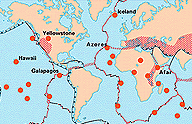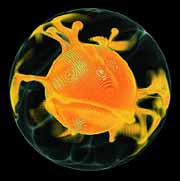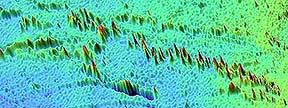
 Although most volcanic rocks are generated at plate
boundaries, there are a few exceptionally active sites of volcanism
within the plate interiors. These intraplate regions of voluminous
volcanism are called hotspots. Twenty-four selected
hotspots are shown on the adjacent map. Most hotspots are thought
to be underlain by a large plume of anomalously hot mantle. These
mantle plumes appear to be generated in the lower
mantle and rise slowly through the mantle by convection. Experimental
data suggests that they rise as a plastically deforming mass that
has a bulbous plume head fed by a long, narrow
plume tail. As the head impinges on the base of
the lithosphere,
it spreads outward into a mushroom shape. Such plume heads are
thought to have diameters between ~500 to ~1000 km.
Although most volcanic rocks are generated at plate
boundaries, there are a few exceptionally active sites of volcanism
within the plate interiors. These intraplate regions of voluminous
volcanism are called hotspots. Twenty-four selected
hotspots are shown on the adjacent map. Most hotspots are thought
to be underlain by a large plume of anomalously hot mantle. These
mantle plumes appear to be generated in the lower
mantle and rise slowly through the mantle by convection. Experimental
data suggests that they rise as a plastically deforming mass that
has a bulbous plume head fed by a long, narrow
plume tail. As the head impinges on the base of
the lithosphere,
it spreads outward into a mushroom shape. Such plume heads are
thought to have diameters between ~500 to ~1000 km.

|
Many scientists believe that mantle plumes may be derived from near the core-mantle boundary, as demonstrated in this computer simulation from the Minnesota supercomputing lab. Note the bulbous plume heads, the narrow plume tails, and the flattened plume heads as they impinge on the outer sphere representing the base of the lithosphere. |
Decompressional melting of this hot mantle source can generate huge volumes of basalt magma. It is thought that the massive flood basalt provinces on earth are produced above mantle hotspots. Although most geologists accept the hotspot concept, the number of hotspots worldwide is still a matter of controversy.
The Pacific plate contains several linear belts of extinct submarine volcanoes, called seamounts, an example of which is the Foundation seamount chain shown here.

|
The Foundation seamount chain is located near Easter Island in the south Pacific. Courtesy of NOAA. |
The formation of at least some of these intraplate seamount chains can be attributed to volcanism above a mantle hotspot to form a linear, age-progressive hotspot track. Mantle plumes appear to be largely unaffected by plate motions. As lithospheric plates move across stationary hotspots, volcanism will generate volcanic islands that are active above the mantle plume, but become inactive and progressively older as they move away from the mantle plume in the direction of plate movement. Thus, a linear belt of inactive volcanic islands and seamounts will be produced. A classic example of this mechanism is demonstrated by the Hawaiian and Emperor seamount chains.
The "Big Island" of Hawaii lies above the mantle plume. It is the only island that is currently volcanically active. The seven Hawaiian Islands become progressively older to the northwest. The main phase of volcanism on Oahu ceased about 3 million years ago, and on Kauai about 5 million years ago. This trend continues beyond the Hawaiian Islands, as demonstrated by a string of seamounts (the Hawaiian chain) that becomes progressively older toward Midway Island. Midway is composed of lavas that are ~27 million years old. Northwest of Midway, the volcanic belt bends to the north-northwest to form the Emperor seamount chain. Here, the seamounts become progressively older until they terminate against the Aleutian trench. The oldest of these seamounts near the trench is ~70 million years old. This implies that the mantle plume currently generating basaltic lavas on the Big Island has been in existence for at least 70 million years!
The Hawaiians were very good at recognizing the difference in the older, eroded volcanic islands and newer islands to the southeast, where volcanic features are more pristine. Legend has it that Pele, the Hawaiian goddess of fire, was forced from island to island as she was chased by various gods. Her journey is marked by volcanic eruptions, as she progressed from the island of Kaua'i to her current home on the Big Island. The legend corresponds well with the modern scientific notion of the age progression of these volcanic islands.
Go to: